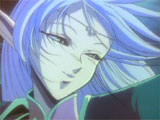

Quick Links:
Record of Lodoss War, OVA Series
Fantasy is a particularly well-defined niche of storytelling, with J.R.R. Tolkien's The Lord of the Rings being its how-to manual. Not that every fantasy epic is Lord of the Rings, but the old novels did define a large number of tenets for the genre, many of which the fantasy stories of today follow faithfully. The most basic defining rule of fantasy is an exaggeration of the trials humanity faces, and its triumphs. The evils are greater and the spoils sweeter than a typical human could ever know. A second tenet that affects most stories in this genre is the fantastical worlds in which they take place. There is a heavy focus on the supernatural, and there are usually multiple intelligent species in addition to man. These stories cater to our almost primal need for excitement like some other genres, but they also aim to make a lasting impression. Record of Lodoss War, the OVA animation, fits squarely within the fantasy genre, especially with regards to what I just said above. It's a tale of debilitating fear and extraordinary courage, of love and war, in a world of elves, magic, and strange creatures.
Lodoss begins with a narrative; a chronicle of an ancient battle between good and evil. On one side is the God of Light (Falis) and on the other the God of darkness (Falaris). Both sides are exhausted until only the Goddess of Creation (Marfa) and Goddess of Destruction (Kardis) remain. The battle between the Goddesses shakes the Earth to its core and a piece of land breaks off from the main continent. This "accursed continent" is named Lodoss. The battle between Marfa and Kardis forms the basis for the story, telling us immediately that another epic battle is brewing. Just when the audience is about to reach negative-imagery overload, we see a man and elf speeding by on a horse - with the hauntingly beautiful opener (Adesso e Fortuna*) playing in the background. The song causes a 180 degree shift in the mood, instantly. The two scenes are an early taste of the character of Lodoss - a dance between challenge and triumph that repeats itself for the duration of the series.
The main plot of Lodoss revolves around a boy named Parn, whose father was a warrior for the monarchy of Valis. Parn gets kicked out of his cozy little town...I mean, "sent on an important mission to the King"...after he pissed off some goblins and they ransacked the place. He is accompanied on this Very Important Mission by his friend Etoh (a priest of Valis), a wizard named Slayn, and a dwarf named Ghim (meaning "duty", and not to be confused with Gimli, because this is not Lord of the Rings. Really!). Along the way, they pick up an attractive female elf named Deedlit, and a man named Wood. (Hmm...two men, an elf, a dwarf, a wizard...Tolkien would be proud.) Then, as per standard fantasy protocol, they prance about the landscape and have adventures while the Big Brewing Evil makes its plans for World Domination.
Lodoss does not study its characters in any great detail, as doing so often goes against the tenets of the genre. Circumstance determines the actions of the characters more than their personalities. To that end the series never lacks in evil to fight, nor in heroic acts. The show plays the genre right, but it also does it well. Since fantasy plots play to extremes, they always walk a fine line between being inspirational or just plain cheesy. Lodoss manages to remain on the right side of the fence because the plot is performance-tuned for the fight, so to speak. There is no attempt to muddy the waters by suggesting the evil might not be so evil, or the hero might not be so righteous. There is no frivolous dialogue or action, nor does the story remain in one setting for long. It's always on the move, increasing the evil and the heroics as it presses on.
The show's character designs support the plot adequately. Evil is represented by dark colors and cruel or calculating expressions, whereas good wears the lighter colors and displays either radiance or determination. The music provides good support as well, and serves to increase the emotional impact. The series doesn't have a regular opening theme, but does have a regular closer - Kaze no Fantasia (Fantasia of the Wind), a lightfooted (elven) love song. The rest of the music is instrumental, including several character-oriented themes.
Record of Lodoss War served to reinforce the fantasy genre requirements in animated form. The series provided adequate foreshadowing to set the stage, and balanced good and evil well enough to give tension to the conflicts. The plot was a well-oiled machine that purred without interruption for the duration, even as the battle for love and survival escalated. The ending left nothing more to be said. Lodoss goes down in my book as one of the crowning examples of what the fantasy genre has to offer.
* A note on the title, "Adesso e Fortuna": A direct translation from Italian to English gives us "Now and Fortune." That doesn't make any sense, so I made a feeble attempt to investigate. I want to say that the author meant to express "Now and Forever" in Italian - better served as "Ora e per Sempre".
Distributor: Central Park Media Creator: Hitoshi Yasuda & Ryo Mizuno / Kadokawa Shoten Released: 1990
Plot: A Character Design: A- Animation Quality: B Music: A Overall: A



